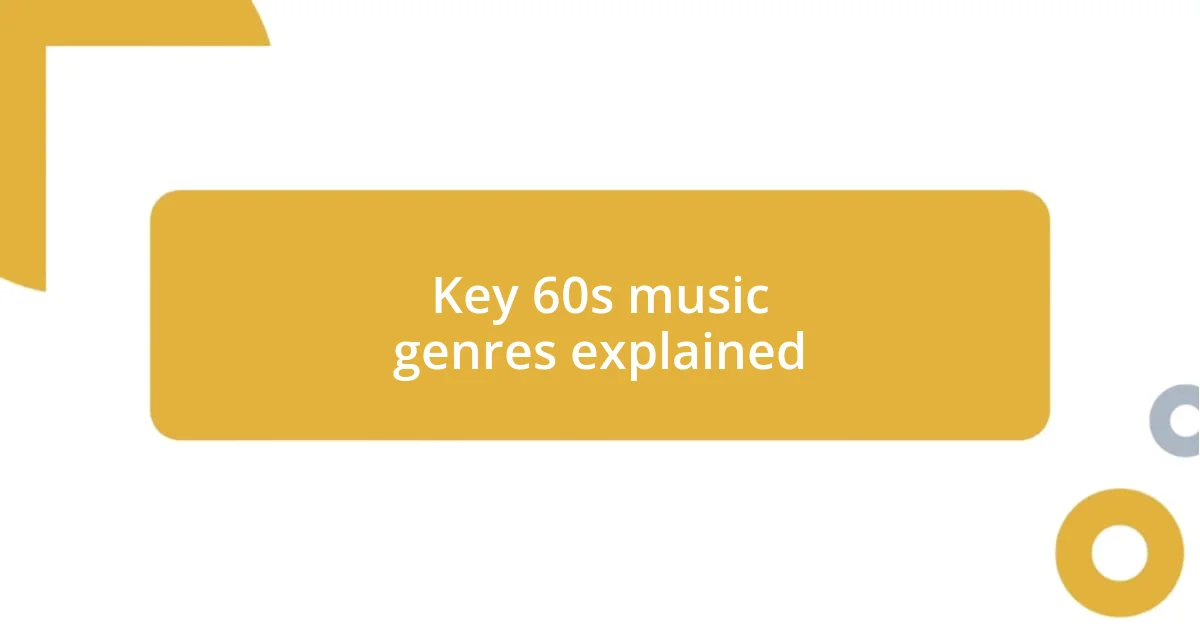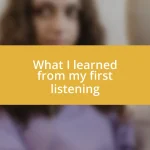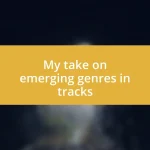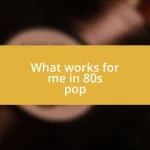Key takeaways:
- The author’s love for 60s music was sparked by iconic artists like The Beatles, Aretha Franklin, and Bob Dylan, whose energy, emotional depth, and storytelling showcased the era’s profound cultural connections.
- Key music genres of the 60s, including rock and roll, pop, folk, psychedelic rock, and soul, reflect the decade’s social movements and emotional struggles, each resonating with audiences in different ways.
- Personal experiences with 60s music, such as family gatherings and civil rights anthems, highlight the genre’s ability to evoke strong emotions, foster community, and inspire a deeper exploration of its historical significance.

Discovering iconic 60s artists
One of my favorite moments was the first time I heard The Beatles’ “A Hard Day’s Night.” I was captivated by their energy and harmonies; it felt like a revelation. What was it about their sound that turned ordinary melodies into something transcendent?
As I dove deeper into the music of the 60s, I stumbled upon artists like Aretha Franklin. Her voice resonated with such power and emotion, it made my heart race. How could one voice carry so much weight in both melody and message? It struck me that the 60s were not just about the tunes; they were also about the profound connections these musicians created with their audiences.
Discovering Bob Dylan was like uncovering a treasure trove of lyrics that told stories. His way with words opened my eyes to the power of songwriting in expressing social change. Could it be that a simple song could ignite movements? I remember sitting with his albums, lost in poetic lines that felt both deeply personal and universally relevant.

Key 60s music genres explained
When I think of the 60s, several key genres stand out, each with its own distinct flavor and influence. Rock and roll, for example, became the heartbeat of the era, driven by electrifying guitars and rebellious lyrics. I recall the first time I heard The Rolling Stones’ “Paint It Black,” and how its dark, haunting tones left a lasting impression on my musical journey. The genre truly embodied freedom and youth, making it relatable and powerful.
- Pop: Melodic and catchy, with artists like The Supremes leading the scene. Their smooth vocals brought a sense of joy and optimism that felt infectious.
- Folk: With its roots in storytelling, Bob Dylan and Joan Baez paved the way for deeper lyrical content that resonated with the social issues of the time.
- Psychedelic Rock: This genre introduced a kaleidoscope of sounds and lyrics, thanks to bands like Jefferson Airplane, inviting listeners to explore their imagination.
- Soul: Artists like Otis Redding and Aretha Franklin brought an emotional depth that stirred the soul, filling it with both happiness and sorrow.
Exploring these genres helped me understand the cultural shifts occurring in the 60s—each genre resonated with people in different ways, capturing the essence of the decade’s spirit and struggles. It wasn’t just music; it was a movement that sparked conversations, inspired change, and forged a unique bond among listeners.

Personal experiences with 60s music
My earliest memories of 60s music are tightly woven with family gatherings. I vividly recall my parents playing records by The Beach Boys while we danced in the living room. The harmonies filled our home with warmth and joy. Even today, when I hear “Good Vibrations,” I’m transported back to that carefree childhood, where the world felt endless and full of promise.
As I grew older, I started to explore the soundtracks of the civil rights movement. Listening to artists like Sam Cooke brings back intense emotions; “A Change is Gonna Come” has a way of making me pause and reflect on the struggles of the past. Its message still resonates today, reminding me that music is a powerful catalyst for change. The way his voice soared above the struggles of his time captivated me, encouraging empathy and awareness in a way that words alone couldn’t.
I also remember the first time I attended a live concert of a 60s tribute band. The energy in the audience was electric, as everyone sang along to classics like “Twist and Shout.” The sense of camaraderie among strangers, united by a shared love for music that has stood the test of time, was exhilarating. Experiencing that moment inspired me to dive deeper into the history of the music, realizing how it could create lasting connections beyond generations.
| Personal Experience | Emotion |
|---|---|
| Dancing with family to The Beach Boys | Joy and nostalgia |
| Reflecting on civil rights music with Sam Cooke | Empathy and awareness |
| Attending a 60s tribute concert | Community and exhilaration |

Building a 60s music collection
Building a 60s music collection is like curating a time capsule of social change and artistic evolution. I remember scouring through thrift stores and garage sales, one day unearthing an old vinyl copy of Jefferson Airplane’s “Surrealistic Pillow.” The moment I placed the needle on the record, the swirling sounds transported me to a psychedelic world, sparking a fascination with not just the music, but the entire cultural revolution it represented.
As I began to accumulate records, each album told a story that resonated beyond mere notes and lyrics. Every time I added a Motown classic to my shelf, like The Temptations’ “My Girl,” I felt a sense of pride. I often wonder, how can a single song evoke warmth and nostalgia in such a powerful way? It’s the magic of the music from that era; it transcends time and speaks directly to the heart.
I found that exploring different artists led me down a rabbit hole of influences and collaborations, revealing a rich web of connections. The sheer excitement of discovering an obscure Folk album by Joan Baez opened my eyes to her contributions as a voice of protest. I could almost feel the electric energy of those legendary performances, and it prompted me to dig deeper into their backgrounds. How could I not be drawn in by the stories behind the songs? They motivated me to keep collecting, knowing each piece would enrich my understanding of a decade that shaped so much of our cultural landscape.














